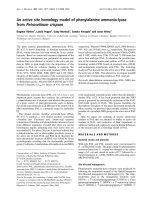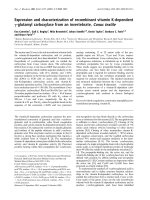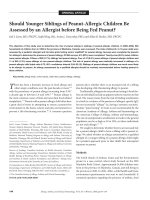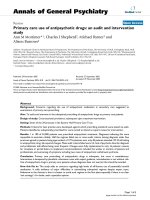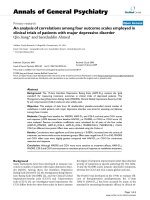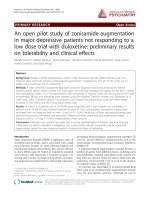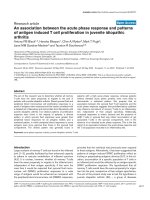Báo cáo y học: "An epidemiological examination of the subluxation construct using Hill''''s criteria of causation" pps
Bạn đang xem bản rút gọn của tài liệu. Xem và tải ngay bản đầy đủ của tài liệu tại đây (395.94 KB, 7 trang )
BioMed Central
Page 1 of 7
(page number not for citation purposes)
Chiropractic & Osteopathy
Open Access
Review
An epidemiological examination of the subluxation construct using
Hill's criteria of causation
Timothy A Mirtz*
1
, Lon Morgan
2
, Lawrence H Wyatt
3
and Leon Greene
4
Address:
1
University of South Dakota, Vermillion, South Dakota, USA,
2
Retired, Meridian, Idaho, USA,
3
Texas Chiropractic College, Pasadena,
Texas, USA and
4
University of Kansas, Lawrence, Kansas, USA
Email: Timothy A Mirtz* - ; Lon Morgan - ;
Lawrence H Wyatt - ; Leon Greene -
* Corresponding author
Abstract
Background: Chiropractors claim to locate, analyze and diagnose a putative spinal lesion known
as subluxation and apply the mode of spinal manipulation (adjustment) for the correction of this
lesion.
Aim: The purpose of this examination is to review the current evidence on the epidemiology of
the subluxation construct and to evaluate the subluxation by applying epidemiologic criteria for it's
significance as a causal factor.
Methods: The databases of PubMed, Cinahl, and Mantis were searched for studies using the
keywords subluxation, epidemiology, manipulation, dose-response, temporality, odds ratio, relative
risk, biological plausibility, coherence, and analogy.
Results: The criteria for causation in epidemiology are strength (strength of association),
consistency, specificity, temporality (temporal sequence), dose response, experimental evidence,
biological plausibility, coherence, and analogy. Applied to the subluxation all of these criteria remain
for the most part unfulfilled.
Conclusion: There is a significant lack of evidence to fulfill the basic criteria of causation. This lack
of crucial supportive epidemiologic evidence prohibits the accurate promulgation of the
chiropractic subluxation.
Introduction
In 1843, John Stuart Mill [1] wrote a book titled "A System
of Logic: Ratiocination and Induction." This text was used to
judge causal relationships through the following means:
method of agreement, method of difference, joint method
of agreement and difference, method residues, and
method of concomitant variation [1]. For a period of
time, this approach served as the conventional wisdom
regarding criteria for causation. It was not until 1965 that
Sir Austin Bradford Hill [2] first summarized the epidemi-
ologic causality criteria. Today, the criteria established by
Sir Austin are applied to contemporary epidemiology as
strength (strength of association), consistency, specificity,
temporality (temporal sequence), dose response, experi-
mental evidence, biological plausibility, coherence, and
analogy. They form the fundamental prerequisites and
assessment criteria of the cause-effect relationship [3].
This criteria have often been referred to as Hill's Criteria
Published: 2 December 2009
Chiropractic & Osteopathy 2009, 17:13 doi:10.1186/1746-1340-17-13
Received: 27 August 2009
Accepted: 2 December 2009
This article is available from: />© 2009 Mirtz et al; licensee BioMed Central Ltd.
This is an Open Access article distributed under the terms of the Creative Commons Attribution License ( />),
which permits unrestricted use, distribution, and reproduction in any medium, provided the original work is properly cited.
Chiropractic & Osteopathy 2009, 17:13 />Page 2 of 7
(page number not for citation purposes)
(Table 1). Ultimately, the strength of the evidence for con-
cluding that there is a cause and an effect is judged by
these criteria.
How does Hill's Criteria apply to the chiropractic sublux-
ation? A fundamental principle of the chiropractic profes-
sion stresses that this putative subluxation is the cause of
"dis-ease," with the use of a hyphen to supposedly distin-
guish it from the term disease. Historically, generations of
chiropractors have contended that a large percentage of all
disease is caused by subluxation [4]. In fact, the early his-
torical paradigm was that 95% of all disease (dis-ease) was
due to subluxations of the spine and that the remaining
5% was caused by subluxations of the extremities, partic-
ularly the joints and feet [5]. A more contemporary view
is that chiropractic health care is based on the premise that
subluxations cause interference in the nervous system
which leads to suboptimal health and symptomatic dis-
ease [6]. The Association of Chiropractic Colleges [7] par-
adigm statement (ACC Paradigm) suggested that
"chiropractic is concerned with the preservation and res-
toration of health, and focuses particular attention on the
subluxation." It also defined a subluxation as "a complex
of functional and/or structural and/or pathological articu-
lar changes that compromise neural integrity and may
influence organ system function and general health." This
paradigm has been endorsed by a number of national and
international organizations, including the American Chi-
ropractic Association, the International Chiropractors'
Association and the World Federation of Chiropractic [8].
Epidemiology is the study of the distribution and determi-
nants of health-related conditions or events in defined
populations and the application of this study to control
health problems [9]. The basic principle of epidemiology
in public health is to measure how disease is distributed
in a specific population and to also determine the factors
that influence or establish this distribution [10]. Epidemi-
ology is about seeking answers to three basic questions.
First, what is the problem? Second, who has the problem?
Finally, why do those with the problem have it? [9] From
these questions one is able to evaluate the cause of dis-
ease, measure its occurrence (prevalence and incidence),
and estimate risks of contracting a disease, by determining
if there are appropriate statistical associations [10]. When
a statistical association between a risk factor and a disease
outcome can be demonstrated, and the results of con-
founding and effect modification have been accounted
for, Hill's Criteria, if satisfied, increase the probability that
the association is causal [1].
If the chiropractic profession is to embrace the subluxa-
tion as a defining factor of health, along with claiming
that intervention to correct this lesion is needed for the
health of the human body, then there exists an obligation
to examine the current status of subluxation against epide-
miological methods and criteria. The purpose of this
paper is to detail Hill's Criteria and how they may be
applied to the concept of subluxation as currently
embraced by the chiropractic profession.
Defining Hill's Criteria
Hill's Criteria consists of the following: strength (strength
of association), consistency, specificity, temporality (tem-
poral sequence), dose response, experimental evidence,
biological plausibility, coherence, and analogy. These
nine criteria form the fundamental prerequisites and
assessment of the cause-effect relationship [3]. Ultimately,
the strength of the evidence for concluding that there is a
cause and an effect is judged by these criteria. Hill's criteria
of causality, as defined by Jenicek, [3] Rothman [11], Last
[12] and Gordis [13] can be organized and defined as pre-
sented in Table 2.
Methods
The databases of PubMed, Cinahl, and Mantis were
searched for studies using the keywords chiropractic, sub-
luxation, epidemiology, manipulation, dose-response,
temporality, odds ratio, relative risk, biological plausibil-
ity, coherence, and analogy. Combinations of the afore-
mentioned terms were also utilized as a search strategy in
order to isolate studies. Studies identified as pertinent to
the purpose of this study were then accessed through the
University of South Dakota's (Vermillion, South Dakota)
Lomman Health Studies Library. When this search strat-
egy failed to reveal any studies associated with the key-
words each of the definitions were then isolated and
additional keywords utilized. From this definition-spe-
cific method were keywords that could be placed in the
search engines. For example, with the consistency criteria
a keyword that was used was gender, race, and socio-eco-
Table 1: Hill's Criteria
1 Strength
2 Consistency
3 Specificity
4 Temporal sequence
5 Dose response
6 Experimental evidence
7 Biological plausibility
8Coherence
9 Analogy
Chiropractic & Osteopathy 2009, 17:13 />Page 3 of 7
(page number not for citation purposes)
nomic status. Other keywords included morbidity and
mortality.
Results
Each one of Hill's Criteria was separated as a unique
entity. The results of this literature review were separated
by strength, consistency, specificity, temporal sequence,
dose response, experimental evidence. Overall, there were
no studies that demonstrated a satisfactory link of evi-
dence to the chiropractic subluxation construct as per
strength, consistency, specificity, temporal sequence, dose
response, experimental evidence, biological plausibility,
coherence, and analogy (Table 3). Specifically, there were
no studies that found subluxation to have a relative risk or
odds ratio. No studies were found that demonstrated the
subluxation to be consistently found in different people
of gender or race, location or even circumstance. Subluxa-
tion was not found to be specifically linked to any one dis-
ease complex. Temporal sequence studies were not noted.
The subluxation was not noted in any studies related to
dose response. Animal based studies that were used to sat-
isfy the experimental evidence were limited. There were
no studies that offered a biological plausibility that would
isolate subluxation as a causal factor in disease. There
were no studies linking the subluxation as a coherent con-
struct and supported by generally known facts about the
natural history and biology of any disease. There were no
studies found that suggested the subluxation as a causal
agent similar to other factually demonstrated causal
agents.
Discussion
Opinion on the current state of the epidemiology of the
subluxation construct is varied. Historically, chiropractors
have claimed that subluxation was directly responsible for
95% of disease. Although this percentage is not currently
in evidence, there still appears to be many chiropractors
that contend subluxation is still partially responsible and/
or involved with disease. The opinion by chiropractors on
the connection of subluxation and disease has been sub-
stantiated. Biggs et al [14] found that 68% of Canadian
chiropractors believed that most diseases were caused by
spinal misalignments whereas 30% of respondents agreed
with the statement that the subluxation is the cause of
many diseases. McDonald et al [15] reported that over
88% of their surveyed chiropractors favored retaining the
term vertebral subluxation complex. Smith and Carber
[16] found that over 70% of chiropractors reported that
subluxation was important to their clinical decisions
which guided the clinical care of the patients. McDonald
et al [15] reported that a strong majority (over 75%) of
their surveyed chiropractors believed that subluxation was
a significant contributing factor to 50% or more of visceral
disorders.
However, opinion from chiropractic scholars on an actual
epidemiology of subluxation appears to be mixed. Meeker
[17] suggested that clinical epidemiology concepts can be
easily related to the chiropractic paradigm linking health,
subluxation, and adjustment. Hawk [18] noted that com-
bining chiropractic terminology and the terminology of
public health and epidemiology one might be able to con-
ceptualize subluxation as a risk factor for a negative health
event since subluxation is not a disease in itself, but is
believed to be a contributing factor to disease, illness or
negative health conditions. McCoy [19,20] noted that the
epidemiology of subluxation has been researched since
the inception of chiropractic over 100 years ago with basic
Table 2: Definitions of Hill's Criteria
Criteria Definition
1 Strength The size of the risk as measured by appropriate tests.
2 Consistency The association is consistent when results are replicated in studies in different settings using different methods.
3 Specificity When a single putative cause produces a specific effect.
4 Temporal sequence Exposure always precedes the outcome.
5 Dose response An increasing level of exposure (in amount and/or time) increases the risk.
6 Experimental evidence The condition can be altered (prevented or ameliorated) by an appropriate experimental regimen
7 Biologic plausibility The association agrees with currently accepted understanding of pathobiological processes.
8 Coherence The association should be compatible with existing theory and knowledge.
9 Analogy A finding of analogous associations between similar factors and similar diseases.
Chiropractic & Osteopathy 2009, 17:13 />Page 4 of 7
(page number not for citation purposes)
science and clinical research to further elucidate the
nature of it and also suggested that research is continuing
to this day. These opinions seem to suggest that an epide-
miology of the subluxation is apparent and/or that sub-
luxation can be studied using epidemiology terminology
and methodology. Nonetheless, Mootz et al [21] con-
firmed the lack of subluxation epidemiology when they
suggested that the agenda for future critical investigation
for the chiropractic profession should include the verte-
bral subluxation complex and epidemiology relating to
incidence, prevalence, and natural history. Walker [22]
noted that if the subluxation as a measurable entity was
valid, it would have to satisfy Hill's Criteria to reach a con-
clusion of causation between subluxation and visceral dis-
ease. Huijbregts [23] noted that many in the manual
medicine field do not share the traditional chiropractic
theoretical position on the causative or contributory role
of spinal and extremity joint dysfunction in the etiology
of disease. It is apparent that there is much disagreement
amongst authors as to whether or not there is an epidemi-
ology of subluxation or if subluxation can conceptually fit
into a model for epidemiological study.
Applying Hill's criteria to chiropractic subluxation
The strength of the evidence for concluding that there is a
cause and an effect association between two entities must
be judged by Hill's Criteria [1]. If the chiropractic sublux-
ation is thought to be a cause, then there must logically be
an effect. In other words, subluxation should be a defina-
ble and distinguishable risk factor to a person's health.
While an in-depth discussion of the intricacies of risk fac-
tors is inappropriate at this time, the concept of a risk fac-
tor as it relates to human health will be explained. When
a statistical association between a risk factor (e.g., putative
subluxation) and a disease outcome (e.g., suboptimal
health) can be demonstrated, Hill's Criteria increases the
probability that the association is causal [1]. It would
seem that this is an accurate assumption when the results
of confounding variables and effect modification have
been controlled. Table 3 summarizes the criteria of causa-
tion and the subluxation.
Hill's Criteria and subluxation: strength
Strength is defined as the size of the risk as measured by
appropriate statistical tests [13] and is based on measure-
ment [3]. It essentially asks the question "is the disease
rate many times greater among an exposed population?"
[3] In other words, the larger the association, the more
likely the exposure is causing the disease [12]. Strength is
measured by relative risk or odds ratios. For example, the
higher the subluxation occurrence (incidence rate) in
exposed subjects compared with unexposed subjects, the
stronger the association [3]. In this case, subluxation
would have to be found in subjects and not found in sub-
jects. As it pertains to the subluxation there has been no
evidence to suggest an incidence rate of subluxation.
Hill's Criteria and subluxation: consistency
Consistency pertains to the association being noted con-
sistently, across many studies in different people, places
and circumstances and times [3]. Results need to be repli-
cated in many studies.
Table 3: Hill's Criteria of Causation Applied to Subluxation
Criteria Result
1 Strength There were no studies that found a relative risk or odds ratio linking subluxation
2 Consistency Subluxation has not been noted to be consistently found across any studies in different people, places, circumstances
or time.
3 Specificity There were no studies that linked disease with subluxation of any specificity. Other exposures (variables) or
explanations can be given to the disease complex.
4 Temporal sequence There were no studies suggestive of a temporal sequence linking subluxation with disease
5 Dose response There were no studies found linking incidence of disease with magnitude of the subluxation
6 Experimental evidence There were no consistent studies demonstrating subluxation in the animal model
7 Biological plausibility No studies were found that offered reproducible evidence to suggest a biological plausibility of the subluxation
construct.
8 Coherence There were no studies that indicated a credible level of coherence
9 Analogy There were no studies suggestive of a casual association via a similar agent.
Chiropractic & Osteopathy 2009, 17:13 />Page 5 of 7
(page number not for citation purposes)
For the chiropractic subluxation to meet this criteria it
(subluxation) would have to be found repeatedly in dif-
ferent persons, places, times, and circumstances. In the
case of a clinical condition, the subluxation would have to
be consistently found with the clinical condition. To date
there has not been a study that has found the subluxation
in any one population (gender, race, ethnicity, age). Or
that any person of gender, race, ethnicity or age is more
prone to subluxation as compared to another group. Fur-
thermore, there were no studies that determined that the
subluxation is consistently present in any clinical condi-
tion.
Hill's Criteria and subluxation: specificity
Specificity reveals that a factor (cause under study) leads
to a consistent pattern of consequences [3]. In other
words, a single putative cause should produce a specific
effect [13]. With regards to the subluxation this is reminis-
cent of the "chart of effects of nerve interference" that are
commonplace in chiropractic offices. This chart suggests
that if a person has a subluxation or nerve interference at
the fourth thoracic level then gall bladder conditions,
jaundice and shingles should be made manifest. For spe-
cificity to be realized a population with any given clinical
diagnosis should have a consistent and specific subluxa-
tion associated with it. For example, if a person does suffer
with the diagnosis of shingles, it should specifically be
noted that the fourth thoracic vertebrae is consistently
associated with shingles. For the myriad of clinical condi-
tions that exist there is not a "most common subluxation"
found. Keating et al [24] noted that a review of enuresis
that subluxation sites for which adjustment has been sug-
gested to relieve enuresis ranges the entire spinal gamut.
Hill's Criteria and subluxation: temporal sequence
Temporal sequence is the only absolutely essential crite-
rion for a cause-effect association [12]. It asks the question
"did the exposure occur before the disease began?" It
(temporal sequence) must be clearly defined as the "cart
is firmly behind the horse" [3]. This suggests that sublux-
ation must always precede the clinical condition for a true
cause and effect scenario to take place. If a subluxation is
present for any period of time, a progression of ill effects
should be observed when there is an increase in magni-
tude over the same period of time. However, to date there
exist no evidence to support a temporal sequence of any
population being exposed to subluxation and the occur-
rence of any clinical condition.
Hill's Criteria and subluxation: biological plausibility
Biological plausibility refers to the coherence with the cur-
rent of body of biologic knowledge [13]. The association
causing an effect must agree with currently accepted
understanding of pathobiological processes [12]. The cri-
terion asks the question "does a pathophysiologic model
of how the exposure could cause the disease make sense?"
[3] Chiropractors often introduce subluxation as a causal
factor for human disease by implicating the nervous sys-
tem as the source of many health problems. No studies
were found that offered reproducible evidence that the
subluxation impairs nerve flow to the visceral organs and
impedes health. Nor were there any studies that suggested
that manipulation of subluxation removes nerve interfer-
ence, restores nerve flow to the organ or eliminates nerve
interference as to affect organ health.
Hill's Criteria and subluxation: dose-response
Dose-response is defined as an increasing level of expo-
sure (in amount and/or time) increases the risk [12].
Dose-response can be approached by asking the question
"does the association show a dose response effect i.e. does
the more exposure a group of people has proportionately
increases the frequency of disease experienced?" [3] This
criterion is an extension of the strength criterion and is
based on measurement [3]. It can be explained as the
measurement of the relationship amount of exposure in
duration, intensity, quality and the size of the impact. The
subluxation construct has yet to be defined in terms of
exposure and response. Dose-response can be explained
in two ways: toxicity and therapeutic. First, is the amount
of exposure for any given thing enough to create pathol-
ogy. Secondly, how much treatment is needed for elimi-
nation of the exposure. From the therapeutic viewpoint if
a person is said to have subluxation then a certain amount
of spinal manipulation should show a response, in some
form, by the human body. If subluxation is a cause of any
disease then logically enough spinal manipulation that is
given to a patient/set of patients should show some type
of response statistically that eliminates the cause. The tox-
icity view is that if subluxation is inherently the cause of
pathology then how much subluxation in duration, inten-
sity, quality and size of the impact is sufficient to create
disease.
There was no evidence suggestive that there should be
more manipulation of subluxation versus no manipula-
tion, or even versus a few manipulations. Studies by Haas
et al [25,26] on dose-response on chronic cervicogenic
headache and chronic low back pain did not make men-
tion of the subluxation construct.
Hill's Criteria and subluxation: experimental evidence
Experimental evidence is defined as the condition can be
altered (prevented or ameliorated) by an appropriate
experimental regimen [12]. Rothman [11] argued that, as
a criterion, experimental evidence cannot be applied to all
settings. As per the subluxation, experimental evidence is
lacking. However, the one area in which the experimental
evidence criterion can be applied to is in the animal
model. For the subluxation construct the question
Chiropractic & Osteopathy 2009, 17:13 />Page 6 of 7
(page number not for citation purposes)
becomes "has the subluxation caused any pathological
state in the animal model?" As well, the suggestion is
made that a subluxation produced or observed in the ani-
mal model does create the environment for impaired
health or lack of nerve flow for impaired end organ func-
tion. With the chiropractic construct of subluxation ani-
mal research is lacking. The only studies found pertaining
to subluxation and animal experiments was DeBoer and
Hansen's [27] and Henderson et al [28] work. These stud-
ies failed to isolate the subluxation as a quantifiable
lesion. Cramer et al [29] noted that while animal studies
are both informative and provocative the small number of
studies is inadequate as an evidence base.
Hill's Criteria and subluxation: coherence
Coherence is the association should be compatible with
existing theory and knowledge [12]. The criterion essen-
tially asks the question "is the association supported by
generally known facts about the natural history and biol-
ogy of the disease?" [3] To qualify as a study to match the
coherence criterion a study would have to have been per-
formed that would have suggested subluxation as a causal
factor of disease and would have to be implicated in a cer-
tain disease or pathological state. In other words, in the
case of a specific disease would the facts of that disease
support the notion that subluxation as the causal factor.
No studies were found that demonstrated that nerve irri-
tation from chiropractic subluxation at the spinal level
produces suboptimal health that requires intervention.
Hill's Criteria and subluxation: analogy
The analogy criterion looks for a disease or exposure that
may have been observed that may be of similarity. It
essentially asks the question if there are no other epidemi-
ologic or experimental studies of this exposure-disease
relationship, has a causal association been established for
a very similar agent? [3] No studies were found that
offered a consistent analogy linking subluxation with
another similar disease-producing agent.
Limitations to utilizing Hill's Criteria
Hill's Criteria do have some limitations. The only crite-
rion of Hill's that is truly a causal criterion is temporality
while suggesting that the other criteria were vague [11].
Although these criteria were never designed to be hard
and fast rules they do provide essential guidelines for
establishing causation [30]. Nevertheless, the criteria of
Hill remain as basic principles in finding causal relation-
ships. Henneken and Buring's criteria are better due to the
incorporation of statistical concepts and de-emphasizes
the weaker criterion of analogy [31]. Nevertheless, if a
concept such as subuxation fails the test established by
Hill's Criteria, it would seem that the application of Hen-
neken and Buring's criteria is premature.
Phillips and Goodman [32] have noted, in relation to
Hill's criteria, that statistical significance should not be
mistaken for evidence of a substantial association, associ-
ation does not prove causation (other evidence must be
considered), precision should not be mistaken for validity
(non-random errors exist), and uncertainty about
whether there is a causal relationship (or even an associa-
tion) is not sufficient to suggest action should not be
taken. However, these same authors noted that evidence
(or belief) that there is a causal relationship is not suffi-
cient to suggest action should be taken [32].
Conclusion
Hill's criteria are the most commonly used epidemiologic
model for suggesting a causal link for any diagnostic or
treatment approach. There is a significant lack of evidence
in the literature to fulfill Hill's criteria of causation with
regards to the chiropractic subluxation. No supportive evi-
dence is found for the chiropractic subluxation being
associated with any disease process or of creating subopti-
mal health conditions requiring intervention. Regardless
of popular appeal this leaves the subluxation construct in
the realm of unsupported speculation. This lack of sup-
portive evidence suggests the subluxation construct has no
valid clinical applicability.
Competing interests
The authors declare that they have no competing interests.
Authors' contributions
TM and LM conceived the idea for the original manu-
script. TM and LM and LG had initial discussions about
this paper. After multiple distributions between all
authors TM wrote the initial manuscripts with LM, LW
and LG undertaking revisions of the work product. LM,
LW, and LG offered editorial support. All authors
approved the final manuscript.
References
1. Dishman RK, Washburn RA, Heath GW: Physical Activity Epide-
miology. Human Kinetics. Champaign, IL; 2004.
2. Hill AB: The environment and disease: association or causa-
tion? Proc R Soc Med 1965, 58:295-300.
3. Jenicek M: Foundations of Evidence-Based Medicine. Partheon
Publishing. Boca Raton; 2004.
4. Keating JC: Letter: Evaluating the quality of clinical practice
guidelines. J Manipulative Physiol Ther 2003, 26(3):1-4.
5. Keating JC: Philosophy: the art of skepticism. J Can Chiropr Assoc
2000, 44(2):79-84.
6. Plaugher G, Long CR, Alcantara K, Silveus A, Wood H, Lotun K,
Menke M, Meeker WC, Rowe SH: Practice-based randomized
controlled-comparison clinical trial of chiropractic adjust-
ments and brief massage treatment at sites of subluxation in
subjects with essential hypertension: pilot study. J Manipulative
Physiol Ther 2002, 25:221-239.
7. Association of Chiropractic Colleges: A position paper on chiro-
practic. J Manipulative Physiol Ther 1996, 19:634-637.
8. Keating JC, Hyde TE, Menke JM, Seaman D, Vincent RE, Wyatt LH: In
the quest for cultural authority. Dyn Chiro 2004, 26(22):1-2.
Publish with BioMed Central and every
scientist can read your work free of charge
"BioMed Central will be the most significant development for
disseminating the results of biomedical research in our lifetime."
Sir Paul Nurse, Cancer Research UK
Your research papers will be:
available free of charge to the entire biomedical community
peer reviewed and published immediately upon acceptance
cited in PubMed and archived on PubMed Central
yours — you keep the copyright
Submit your manuscript here:
/>BioMedcentral
Chiropractic & Osteopathy 2009, 17:13 />Page 7 of 7
(page number not for citation purposes)
9. Green LW, Kreuter MW: Health Promotion Planning: An Edu-
cational and Ecological Approach. Third edition. Mayfield Pub-
lishing Company. Mountain View, California; 1999.
10. Colley F, Morgan L, Haas M: Reply to "issues" in chiropractic
pediatrics: vaccination. Dyn Chiro 1998, 16(9):.
11. Rothman KJ: Epidemiology: An Introduction. Oxford University
Press. New York, NY; 2002.
12. Last JM: A Dictionary of Epidemiology. 4th edition. Oxford Uni-
versity Press. New York, NY; 2001.
13. Gordis L: Epidemiology. 3rd edition. Elsevier Saunders. Philadel-
phia. PA; 2004.
14. Biggs L, Mierau D, Hay D: Measuring philosophy: a philosophy
index. J Can Chiropr Assoc 2002, 46(3):173-183.
15. McDonald WP, Durkin KF, Pfefer M: How chiropractors think
and practice: The survey of North American chiropractors.
Sem Integrative Med 2004, 2(3):92-98.
16. Smith M, Carber LA: Survey of US chiropractor attitudes and
behaviors about subluxation. J Chiropr Hum 2008, 15:19-26.
17. Meeker WC: Teaching skills that fit the needs of the clinician:
an argument for the role of clinical epidemiology in teaching
evidence-based practice. WFC/ACC/NBCE: Innovations and Chal-
lenges in Clinical Education 2002.
18. Hawk C: Toward a wellness model for chiropractic: the role
of prevention and health promotion. Topics Clin Chiro 2001,
8(4):1-7.
19. McCoy M: Stroke, chiropractic and subluxation: sorting fact
from fiction. Research Update: Journal of Vertebral Subluxation
Research 2002.
20. McCoy M: Telling Time the truth. The Chiro J 2001.
21. Mootz RD, Shekelle PG, Hansen DT: The politics of policy and
research. Topics Clin Chiro 1995, 2(2):56-70.
22. Walker BF: President's Report: Type "O" disorders. COMSIG
Rev. 1993, 2(2):29-30.
23. Huijbregts PA: The chiropractic subluxation: implications for
manual medicine. J Manipulative Physiol Ther 2005, 13(3):139-141.
24. Keating JC, Carlton KH, Grod JP, Perle SM, Sikorski S, Winterstein JF:
Subluxation: dogma or science? Chiro & Osteo 2005, 13:17.
25. Haas M, Groupp E, Aicken M, Fairweather A, Ganger B, Attwood M,
Cummins C, Baffes L: Dose response for chiropractic care of
chronic cervicogenic headache and associated neck pain: a
randomized pilot study. J Manipulative Physiol Ther 2004,
27:547-553.
26. Hass M, Groupp E, Kraemer DF: Dose-response for chiropractic
care of chronic low back pain. Spine J 2004, 4:574-583.
27. DeBoer KF, Hansen JM: Biomechanical analysis of an induced
joint dysfunction (subluxation-mimic) in the thoracic spine
of rabbits. J Manipulative Physiol Ther 1993, 16(2):74-81.
28. Henderson CR, Cramer GD, Zhang Q, DeVocht JW, Fourmier JT:
Introducting the external link model for studying spine fixa-
tion and misalignment: part 2, biomechanical features. J
Manipulative Physiol Ther 2007, 30:279-294.
29. Cramer G, Budgell B, Henderson C, Khalsa P, Pickar J: Basic science
research related to chiropractic spinal adjusting: the state of
the art and recommendations revisited. J Manipulative Physiol
Ther 2006, 29:726-761.
30. Lucas RM, McMichael AJ: Association or causation: evaluating
links between "environment and disease". Bull World Health
Organ 2005, 83(10):792-795.
31. Henneken CH, Buring JE: Epidemiology in Medicine. Edited by:
Mayrent SL. Little, Brown and Company. Boston; 1987.
32. Phillips CV, Goodman KJ: The mixed lessons of Sir Austin Brad-
ford Hill. Epidemiol Perspect Innov 2004, 1:1-5.

